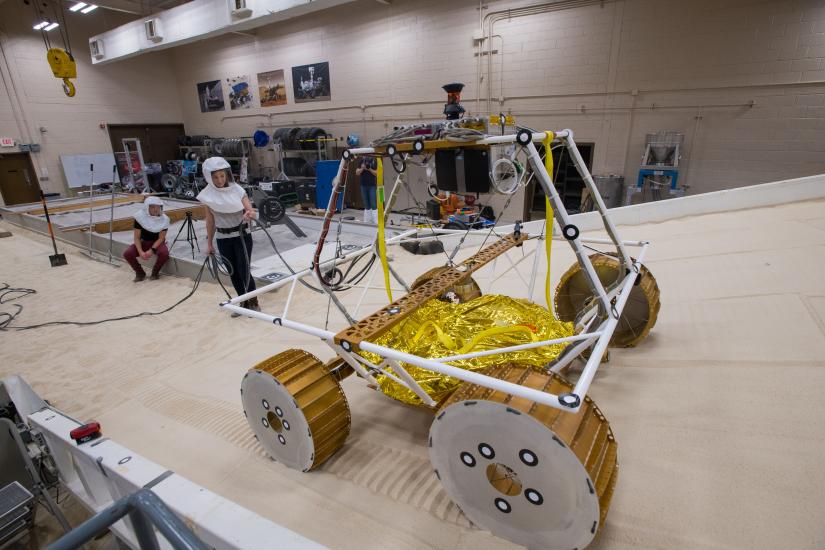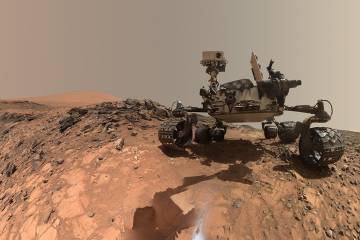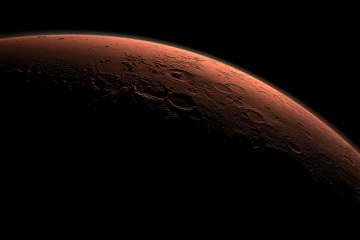- Name
- Johns Hopkins Media Relations
- jhunews@jhu.edu
- Office phone
- 443-997-9009
In the fall of 2023, a U.S. rover will land at the south pole of the moon. Its mission: to explore the water ice that scientists know lurks within the lunar shadows, and which they believe could help sustain humans who may one day explore the moon or use it as a launching pad for more distant space exploration.
NASA recently selected Kevin Lewis, an associate professor in the Krieger School's Department of Earth and Planetary Sciences who has also worked on missions on Mars, as a co-investigator of the mission. Using part of the rover's navigational system, he plans to explore the moon's subsurface geology from his office in Olin Hall.
"I have been on other rover missions, but on Mars, so I'm a little bit new to the moon," Lewis said. "We're going to see into shadows that have never seen the sun, let alone been seen by humans. So it could be a very different type of surface than we've seen in other photos of the surface of the moon."
Drier than a desert
Most of the moon is completely without water. That's because of the way the satellite was formed, in a giant impact between the proto-Earth and a Mars-size object. Temperatures were high enough not only to melt rock, but to vaporize it, causing a cloud of rock vapor to orbit Earth. The vapor eventually coalesced to form the moon.
Those temperatures were also high enough to drive off any water, not even leaving appreciable traces trapped within rocks the way it is on Earth. But over time, meteors and comets containing water ice bombarded the moon, sending ice molecules hopping around the lunar surface.
The sun's angle at the moon's poles is steep, creating long shadows. This means that some of the polar craters receive no sunlight at all. When the water molecules happen to hop into one of those unlit areas, whose temperatures are among the coldest in the solar system at just tens of degrees above absolute zero, it drains their thermal energy and they remain stuck to the surface.
"So, over time, you could build up ice deposits in these permanently shadowed regions, which might be basically the only source of water on the entire moon in useful quantities," Lewis said.
Roving the moon
The Volatiles Investigating Polar Exploration Rover, or VIPER, is a golf cart-sized robot designed for the extremes and unknowns of the moon's south pole. The rover, which will travel several kilometers over several lunar days—or about 100 Earth days—will assess things like what form the water is in, how much of it is there, whether it's more like frost on the surface or ice at depth, and whether there's more of it in some areas than others.
Currently being assembled at NASA's Johnson Space Center in Houston, VIPER has to be customized for the specific conditions it will encounter at the moon's south pole. There's the cratered soil with various levels of compaction, requiring four independently controlled wheels that can handle slopes of 25 to 30 degrees.
There are the moon's drastic temperature swings, ranging from 225 degrees Fahrenheit in the sun during the day to -400 degrees in those permanent shadows; VIPER's boxy shape protects the instruments, and calibrations of the high-precision technology are currently underway to guard against those swings.
There's the darkness itself, necessitating the first headlights ever used on a rover, to illuminate places on the moon that have never seen sunlight.
And there are the conflicting needs of science and logistics—the science calls for VIPER to spend its time in the shadows, but the rover will also need to periodically climb out of the craters to recharge its batteries in the sunlight. Most rovers' solar arrays are located on their roofs, but the angle of the polar sunlight requires VIPER's arrays to be mounted on its sides instead.
The quest
NASA selected eight new VIPER co-investigators, in part to bring new ideas and expertise to the team. Lewis' investigation effectively gives the rover a whole new science instrument for probing the moon.
To track its position and orientation, VIPER is outfitted with accelerometers—devices that are typically used to determine changes in position and rover tilt. These are the instruments that Lewis plans to repurpose for his research. The accelerometers are extremely sensitive; they can detect the minuscule change in gravity you would experience if there was an ore deposit beneath the ground you are standing on.
"Gravimetry has been utilized for prospecting on the Earth; you can look at gravity anomalies, and they will tell you something about the subsurface geology," Lewis said. "We've been able to do that on Mars and figure out the density of the subsurface rocks we're driving over. We're going to do that on the moon as well, and try to figure out the vertical density of the regolith and look for any geological anomalies."

Image caption: A prototype of the VIPER moon rover is tested in the Lunar Operations Lab
Image credit: NASA
VIPER is part of NASA's Artemis program, a multi-phase process to return humans to the moon. Artemis I will be the first test of the rocket that will eventually carry humans, and is scheduled for launch this year. Artemis II, scheduled for 2023, will orbit the moon with humans aboard. Artemis III is planned to land humans on the surface of the moon in 2024.
"It's pretty wild to be working on the VIPER mission in parallel with the human exploration side with the Artemis program," Lewis said. "Even though those astronauts would not directly be drinking this water, it's very cool to be doing this against the backdrop of actually returning to the moon."
As a member of the science team, Lewis isn't involved in constructing VIPER, and he won't be directly handling any of the controls during the mission. But since joining the team, he's been involved in simulated operations, where the team practices using the rover's technology and making the kind of decisions that will need to be made on the spot.
The mission is beginning to seem real. "It's just really exciting to be prospecting for water that could potentially be used by human explorers someday," Lewis said. "Finding water that they could drink a bottle of someday—that kind of blows your mind. And of course the geology side of it: The history of the moon and the geologic and thermal evolution of its crust are also very interesting questions."
Planetary and lunar scientists Kathleen Mandt and Parvathy Prem from the Johns Hopkins Applied Physics Laboratory were also selected as VIPER team members.
Posted in Science+Technology
Tagged astronomy, earth and planetary sciences, space@hopkins










